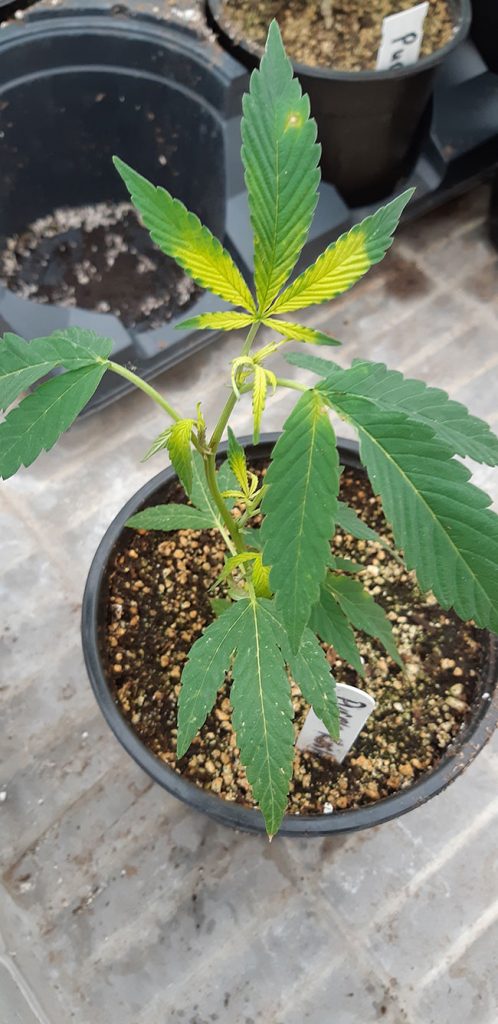
Features
Cultivation
Extraction
Production
Understanding heat and humidity for bud growth and quality
July 30, 2019 By Mohyuddin Mirza
 This cannabis plant was grown in very warm day and night temperatures.
This cannabis plant was grown in very warm day and night temperatures. Temperature in the greenhouse or indoor operations has to be understood as it affects growth and development of cannabis.
To understand temperature and how it affects greenhouse or indoor climate, consider the energy inputs to a typical greenhouse where natural light is allowed to come in and supplemental lights are used for cannabis production year-round. When sunlight or solar energy falls on a greenhouse glazing material, 19 per cent is reflected back into the air, 12 per cent is absorbed by the material, and 69 per cent is transmitted into the greenhouse enclosure. This transmission percentage can vary in different materials like glass, plastic or acrylic. The figures for these materials are also very important to know. Out of the light that enters the greenhouse, 14 per cent is reflected, 17 per cent is given off as heat and 38 per cent is used in evapotranspiration.
Cannabis plants, like other greenhouse crops, are relatively inefficient users of light. Only 5 to 20 per cent of light entering the greenhouse is used by the plants to manufacture sugars; the balance is either reflected, transmitted or used for transpiration. In indoor operations, the amount of light is fixed in terms of “installed capacity” but the intensity can be changed by the distance between the lights and the plants. As the plants grow upward, the light intensity increases at the top of the canopy, and lower leaves get less light. Most of the yellow leaves we see in a plant are at the bottom.
Temperature and relative humidity
There is some confusion about what is ideal relative humidity (RH) for cannabis production. The confusion is that RH should not be used as a “stand alone” parameter; instead, it is related with temperature. RH and temperature should go hand in hand. They are related and dependent on each other.
RH is the amount of water vapour in the air at a given temperature, compared to the maximum water vapour air could hold at saturation. The warmer the air, the more water vapour it can hold, thus reducing the relative humidity in the greenhouse air. For example, at zero degrees Celsius, air can hold four to eight grams of water vapor/m3. Whereas at 30C it can hold 30.4 grams/m3 of water vapour. Humidity plays an important role in a number of key areas of cannabis production and performance. These include vapour pressure deficit, degree of stomatal opening, and dew point.
VapoUr pressure deficit (VPD)
VPD is a measure of water loss from the cannabis plant. It is a measurement calculated by the environmental control computers and reported in grams/m3 of air, kilopascals or millibars. I use grams/m3 of air more than the other two measurements. VPD provides an idea of transpiration loss from leaves and it depends on temperature and relative humidity. Temperature, in this case, should be of the leaf not just the air temperature. A VPD of between 3 and 7 grams/m3 of air during the light periods is a general guideline for cannabis plant performance. During dark periods a VPD of above 1.5 to 2 grams/m3 is desirable. A VPD of below 1 gram/m3 of air indicates very high RH, and poses a danger of condensation on the leaves and buds if proper temperature ramping is not practiced. Growers can use the principle of VPD to target optimum growth environment.
Dew point
I am seeing more and more leaf symptoms on cannabis which appear to be related to dew forming on the leaf surface. I have also seen water dripping from cannabis greenhouse roofs, although relatively less in indoor operations. In one case I saw condensation on walls, which means that these surfaces were cold enough for water vapors to condense and thus form dew. Dew point is reached when RH is very high and the temperature drops.
As an example, at 25C temperature and 65 per cent RH, dew point is 18C. At 70 per cent RH, dew point is 19.1C, at 80 per cent RH the dew point is 21.3 C, and at 100 per cent RH, it is 25C. It is important to understand the temperature and RH interactions carefully and apply it to cannabis management on a daily basis.
The picture shown here is of a young cannabis plant in a greenhouse where plants were grown at very warm day (30C) and night (22C) temperatures. The leaves grew fast and chlorophyll did not keep up with the leaf expansion.
Carefully analyze your temperature and RH data on a daily basis. Also check that out of the lighted period, how many hours the plants were in that window of 3 to 7 grams/m3. If VPD is not in the proper range, then the plant is not “working” properly to make good buds for you. I find that out of 18 hours of lighted period, the plants were barely in that VPD range for eight hours. So lots of energy may be being wasted at the expense of bud size and quality.
Dr. Moyhuddin Mirza is the chief scientist with the Cannabis Nature Company in Edmonton, and is a consultant with the cannabis industry. Email him at drmirza@cannabisnature.ca
Print this page